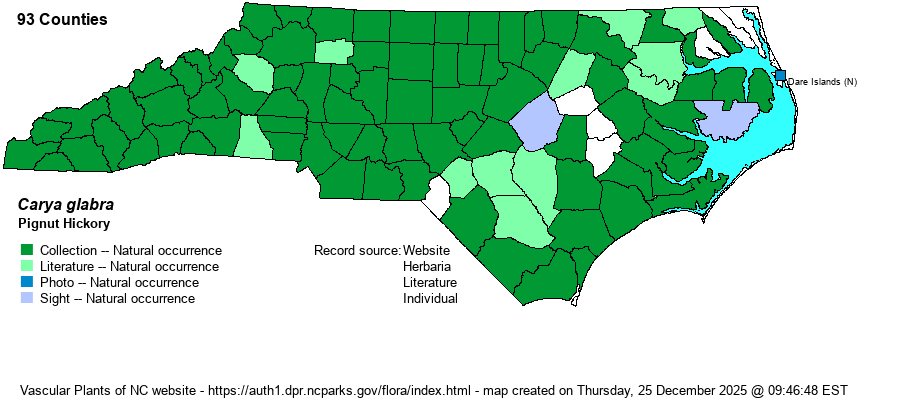| Section 6 » Order Juglandales » Family Juglandaceae |
Show/Hide Synonym
| taxonName | relationship | relatedTaxonName | relatedTaxonRefText | relComments |
|---|
| Carya glabra | > | Carya glabra var. megacarpa | Gleason (1952) | | | Carya glabra | > | Carya glabra var. megacarpa | | | | Carya glabra | > | Carya ovalis var. hirsuta | Fernald (1950) | | | Carya glabra | < | Carya glabra | Flora of North America (1993b, 1997, 2000, 2002a, 2002b, 2003a, 2004b, 2005, 2006a, 2006b, 2006c, 2007a, 2009, 2010) | | | Carya glabra | < | Carya glabra | | | | Carya glabra | < | Carya glabra | | | | Carya glabra | > | Hicoria glabra var. glabra | Small (1933, 1938) | | | Carya glabra | > | Hicoria glabra var. hirsuta | Small (1933, 1938) | | | Carya glabra | > | Hicoria austrina | Small (1933, 1938) | | | Carya glabra | = | Carya glabra var. glabra | Wofford (1989) | | |
|
|
|
|
|
|
| Carya glabra | > | Carya glabra var. glabra | Fernald (1950) | | | Carya glabra | > | Carya glabra var. glabra | Gleason (1952) | | | Carya glabra | > | Carya glabra var. glabra | | | | Carya glabra | > | Carya glabra var. megacarpa | Fernald (1950) | | | Source: Weakley's Flora |
|
| Author | (P. Miller) Sweet | |
| Distribution | Assumed to be statewide, including far eastern counties. There is an odd gap in collection records for the west-central Coastal Plain and southern portions of the Sandhills, where there are no collections. Is it really absent to very rare in this area? Though likely not truly absent in any of these counties, many -- such as the three along the Roanoke River (Northampton, Bertie, and Martin) and several in the southern portion (Cumberland, Sampson, and Bladen) -- have been heavily botanized over the decades. Why is this species so scarce in these places, yet more widespread again farther to the east? The answer lies in the "better", finer-textured, loamier soils of the Piedmont and outer portions of the Coastal Plain.
A widespread species in the East, ranging from NH and MI south to southern FL and eastern TX. Seemingly present in nearly all counties in this large range.
| |
| Abundance | Common and widespread in the Piedmont and Mountains. Infrequent to fairly common, to locally common, in eastern half of the Coastal Plain. Surprisingly rare to uncommon in much of the western half of the Coastal Plain, including the Sandhills; this is clearly not an artifact of collection effort. | |
| Habitat | This is a species of upland to mesic forests, found more often in drier sites, but it also grows well in bottomland forests. It can be one of the common species in Dry-Mesic Oak-Hickory Forest natural community, but it is not uncommon to see large trees growing in the rich soil of bottomland hardwoods. |
| Phenology | Flowers in April and May, and fruits in October. | |
| Identification | This is a very familiar species to all biologists, found in many if not most mature upland forests in the state. It is a medium to large deciduous tree, growing to 80-100 feet tall or taller, more so in bottomlands. Its alternate leaves usually have only 5 leaflets, but both Shagbark Hickory (C. ovata) and Southern Shagbark Hickory (C. carolinae-septentrionalis) also usually contain 5 leaflets. Unlike those, the bark of Pignut Hickory is not shaggy, but is tight. This species can be confused with several others, but Mockernut Hickory (C. tomentosa) has its bark often in diamond-shaped ridges, has larger leaves and leaflets, usually with 7 (or 9) leaflets, and large twigs and buds. Red Hickory (C. ovalis) is very similar, as it also has slender twigs and small buds, but it most often has 7 leaflets, and its petioles usually have some hint of pink or red coloration. See other species accounts for more identification comments. | |
| Taxonomic Comments | Some references have this species split out into varieties. Red Hickory has often been considered as a variety – C. glabra var. ovalis, but most recent references, even RAB (1968), consider it as a good species. NatureServe lists not only the nominate variety but also var. hirsuta as occurring in the state. Weakley (2018) does not list varieties.
| |
| Other Common Name(s) | Pignut, and several other seldom used names. | |
| State Rank | S5 | |
| Global Rank | G5 | |
| State Status | | |
| US Status | | |
| USACE-agcp | FACU link |
| USACE-emp | FACU link |

